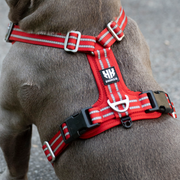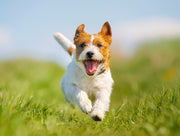The Ultimate Guide to Dog Grooming: Tips, Techniques, and Trends in the UK

Introduction
Best dog grooming products goes beyond a simple bath and brush; it's an essential component of your furry friend's health and well-being. With the surge in dog ownership across the UK, the demand for grooming services and products has never been higher. A well-groomed dog is not only a happy and healthy dog but also a source of pride for pet owners. This guide aims to cover everything from basic grooming tips to professional services and DIY grooming techniques, ensuring your pet looks and feels its best. Whether you're a seasoned dog owner or new to the world of pet care, this ultimate guide to dog grooming in the UK will provide you with all the information and tips you need to keep your canine companion in top condition.

The Essentials of Dog Grooming
Brushing and Combing
Regular brushing is a cornerstone of good grooming. It helps to remove dirt, dander, and loose hair, preventing mats and keeping the coat shiny. The type of brush or comb you use can vary greatly depending on your dog's breed and coat type. For instance, bristle brushes are ideal for short-haired breeds, while slicker brushes are better suited for dogs with longer fur. Incorporating brushing into your daily routine not only keeps your dog's coat in excellent condition but also provides a great opportunity for bonding.
Bathing
Bathing your dog too frequently can strip their coat of natural oils, leading to dry skin and irritation. Generally, dogs should be bathed every three months, though this can vary based on their activity level and breed. When it comes to choosing a shampoo, opt for a mild, dog-specific formula that caters to your pet's skin condition. Remember to brush your dog before a bath to remove tangles and to use lukewarm water to keep them comfortable throughout the process.
Nail Trimming
Trimming your dog's nails is vital to prevent pain and discomfort while walking. Overgrown nails can also lead to problems with their posture and general mobility. If you can hear your dog's nails clicking on the floor, it's time for a trim. Using a specially designed dog nail clipper, cut small amounts of the nail at a time, avoiding the quick, which is the pink area containing blood vessels and nerves. If you're unsure about trimming your dog's nails yourself, consider seeking help from a professional groomer.
Professional Dog Grooming Services in the UK
Finding a Qualified Groomer
The importance of finding a qualified dog groomer cannot be overstated. A good groomer not only ensures your dog looks their best but also checks for signs of health issues, such as skin problems or tooth decay. Look for groomers with certifications from reputable organizations, such as the British Dog Groomers' Association, which indicates they adhere to high standards of care and professionalism.
Popular Dog Grooming Services
In the UK, dog owners can choose from a variety of grooming services. Full grooming sessions typically include a bath, brush, haircut, nail trimming, and ear cleaning. Breed-specific grooming is also popular, catering to the unique needs of different dog breeds, from the thick coat of a Siberian Husky to the delicate fur of a Yorkshire Terrier. Many groomers also offer additional services like teeth cleaning, anal gland expression, and even spa treatments for the ultimate pampering experience.
This introduction and first two sections set the stage for a comprehensive and engaging guide to dog grooming tailored for the UK market. Let's proceed with the next sections, focusing on DIY grooming and care for different breeds.

DIY Dog Grooming at Home
Grooming Tools and Supplies
Equipping yourself with the right tools and supplies is the first step to successful athome dog grooming. Essential items include a quality dog shampoo, conditioner (for those with longer fur), brushes and combs appropriate for your dog's coat type, nail clippers, and a pet-safe toothbrush and toothpaste. For those in the UK, brands like Animology, Pet Head, and FURminator offer a range of products that cater to different grooming needs. Investing in a good grooming table can also make the process easier, especially for larger breeds or dogs that tend to squirm.
Step-by-Step Guide to Home Grooming
1. Brushing: Start with a thorough brushing to detangle and smooth the coat, which helps in reducing shedding and makes subsequent bathing more effective.
2. Bathing: Use lukewarm water and apply dog-specific shampoo. Massage gently from head to tail, avoiding the eyes and ears. Rinse thoroughly to prevent irritation caused by shampoo residue
3.Drying: Towel-dry your dog gently, followed by a blow dryer on a cool setting if your dog isn't afraid of the noise. Ensure they're completely dry to avoid any skin issues.
4. Nail Trimming: Clip your dog's nails carefully, avoiding the quick. If you're unsure, just trim a small amount or consult a professional groomer.
5. Ear Cleaning: Clean the ears with a gentle, dog-specific ear cleaner to prevent infections. Be cautious not to insert the cleaning tool too deep into the ear canal.
6. Teeth Brushing: Regular teeth brushing is vital for oral health. Use a dogspecific toothpaste and brush gently along the gum line.

Dog Grooming Tips for Different Breeds
Breed-Specific Grooming Needs
Every dog breed has unique grooming needs. For example, Labrador Retrievers require regular brushing to manage shedding, but they typically need baths only every two months unless they get particularly dirty. French Bulldogs, with their short coat, require minimal grooming but should have their folds cleaned regularly to avoid infection. Cockapoos, with their curly fur, may require more frequent brushing to prevent mats and tangles, as well as regular trims to keep their coat manageable.
Addressing Common Grooming Challenges
• Matting: For breeds with long hair, matting can be a significant issue. Regular brushing and detangling sprays can help, but severe mats may need to be carefully cut out.
• Sensitive Skin: Dogs with sensitive skin can benefit from hypoallergenic or oatmeal-based shampoos. Always rinse thoroughly to avoid irritation.
• Fear of Grooming: Gradual acclimation to grooming tools and lots of positive reinforcement can help ease anxiety. Start with short sessions and gradually increase as your dog becomes more comfortable.
Trends and Innovations in Dog Grooming
The UK dog grooming industry is seeing exciting trends and innovations. Eco-friendly and natural grooming products are becoming increasingly popular among environmentally conscious pet owners. Mobile grooming services offer convenience, bringing professional grooming to your doorstep. Moreover, grooming apps and online tutorials provide dog owners with the knowledge and tools to tackle grooming at home, making professional-looking results more achievable than ever.
Conclusion
Regular grooming is not just about keeping your dog looking good; it's an essential part of their health and happiness. Whether you choose professional grooming services or prefer the DIY approach, the key is consistency and care. By incorporating the tips and techniques outlined in this guide, you can ensure your dog remains healthy, happy, and well-groomed. Remember, grooming is also a bonding experience, offering a special time for you and your pet to connect and enjoy each other's company. So, grab your grooming tools, and let's make every dog in the UK not just well-groomed, but also well-loved.


